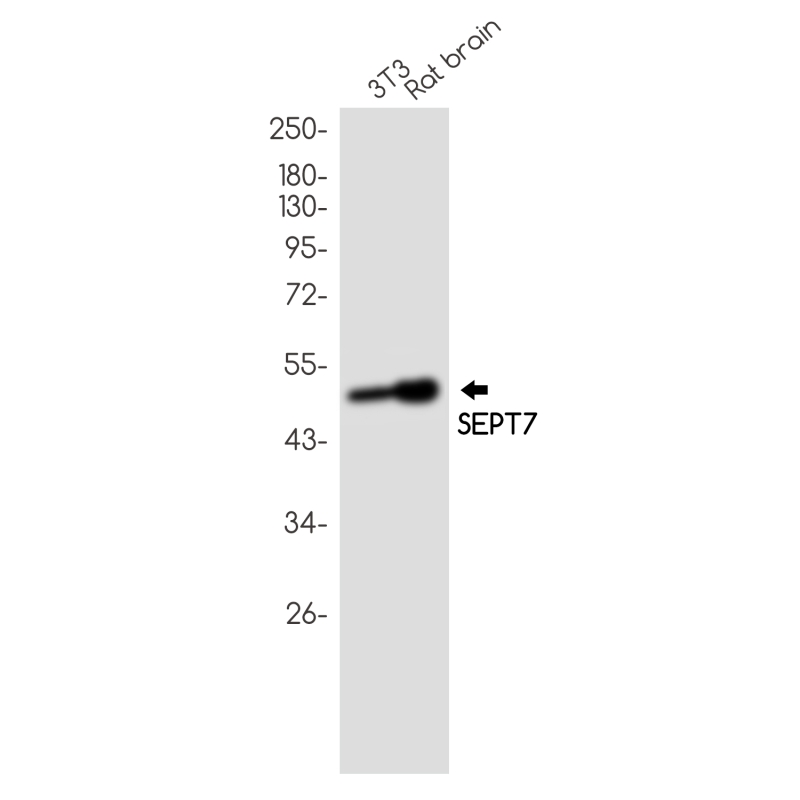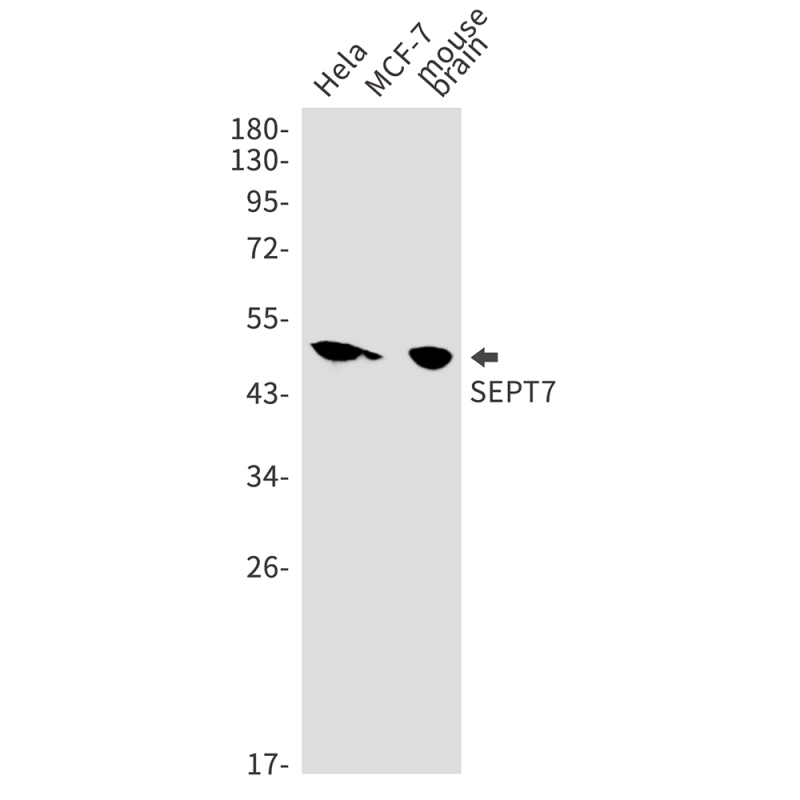

| WB | 1/500-1/1000 | Human,Mouse,Rat |
| IF | 咨询技术 | Human,Mouse,Rat |
| IHC | 咨询技术 | Human,Mouse,Rat |
| ICC | 1/50-1/200 | Human,Mouse,Rat |
| FCM | 咨询技术 | Human,Mouse,Rat |
| Elisa | 咨询技术 | Human,Mouse,Rat |
| Aliases | septin 7; CDC3; CDC10; SEPT7; SEPT7A; NBLA02942 |
| Entrez GeneID | 989 |
| WB Predicted band size | Calculated MW: 51 kDa; Observed MW: 51 kDa |
| Host/Isotype | Rabbit IgG |
| Antibody Type | Primary antibody |
| Storage | Store at 4°C short term. Aliquot and store at -20°C long term. Avoid freeze/thaw cycles. |
| Species Reactivity | Human,Mouse,Rat |
| Immunogen | Recombinant protein of human SEPT7 |
| Formulation | Purified antibody in TBS with 0.05% sodium azide,0.05%BSA and 50% glycerol. |
+ +
以下是3篇关于Septin 7抗体的参考文献及其摘要内容概括:
1. **文献名称**:*"Septin 7 is required for centrosome integrity and progression through mitosis"*
**作者**:Surka, M. C., Tsang, C. W., & Trimble, W. S.
**摘要**:研究利用Septin 7特异性抗体进行免疫荧光和蛋白质印迹分析,发现Septin 7在维持中心体结构和有丝分裂进程中起关键作用,缺失会导致染色体分离异常。
2. **文献名称**:*"Septin 7 interacts with KIF20A and regulates its localization during cytokinesis"*
**作者**:Nagata, K., & Inagaki, M.
**摘要**:通过Septin 7抗体共免疫沉淀实验,揭示Septin 7与驱动蛋白KIF20A的相互作用,调控其在胞质分裂中的定位,影响细胞分裂的完成。
3. **文献名称**:*"Role of Septin 7 in neuronal development and axon guidance"*
**作者**:Xie, Y., Vessey, J. P., & Zheng, J. Q.
**摘要**:利用Septin 7抗体进行免疫组织化学分析,发现Septin 7在神经元突触形成和轴突导向中发挥重要作用,影响神经网络的发育。
4. **文献名称**:*"A monoclonal antibody against Septin 7 modulates mitochondrial dynamics"*
**作者**:Kim, M. S., Froese, C. D., & Chan, C. C.
**摘要**:开发了一种特异性Septin 7单克隆抗体,并证实其通过干扰Septin 7与线粒体分裂蛋白的相互作用,调控线粒体形态和功能。
这些研究均依赖Septin 7抗体探究其在细胞分裂、神经发育及细胞器动态中的功能。
The septin family comprises GTP-binding proteins involved in diverse cellular processes, including cytokinesis, membrane remodeling, and cytoskeletal organization. Septin 7 (SEPT7), a conserved member of this family, forms hetero-oligomeric complexes critical for maintaining cell structure and polarity. As a key component of the septin core complex, it interacts with SEPT2. SEPT6. and SEPT9 to assemble into filaments that regulate cell division, vesicle trafficking, and neuronal development.
Antibodies against SEPT7 are widely used to study its localization, expression, and function in both normal and pathological contexts. These antibodies, typically raised in rabbits or mice using purified recombinant SEPT7 fragments, enable detection via Western blotting, immunofluorescence, and immunohistochemistry. Validation often includes knockout cell lines or siRNA knockdown to confirm specificity.
Research using SEPT7 antibodies has revealed its involvement in neurodegenerative diseases (e.g., Alzheimer's), cancer progression, and infectious processes. In neurons, SEPT7 participates in synaptic plasticity and axonal transport, while its dysregulation correlates with tumor invasiveness and chemoresistance. Commercially available antibodies vary in epitope targets (N-terminal, C-terminal, or internal regions), requiring careful selection based on experimental needs. Recent studies also employ phospho-specific SEPT7 antibodies to investigate post-translational modifications regulating its activity during cell cycle progression.
These tools remain essential for elucidating septin biology and exploring therapeutic targets in septin-associated disorders.
×